I want to perform polynomial calculus in Python. The polynomial package in numpy is not fast enough for me. Therefore I decided to rewrite several functions in Fortran and use f2py to create shared libraries which are easily imported into Python. Currently I am benchmarking my routines for univariate and bivariate polynomial evaluation against their numpy counterparts.
In the univariate routine I use Horner's method as does numpy.polynomial.polynomial.polyval. I have observed that the factor by which the Fortran routine is faster than the numpy counterpart increases as the order of the polynomial increases.
In the bivariate routine I use Horner's method twice. First in y and then in x. Unfortunately I have observed that for increasing polynomial order, the numpy counterpart catches up and eventually surpasses my Fortran routine. As numpy.polynomial.polynomial.polyval2d uses an approach similar to mine, I consider this second observation to be strange.
I am hoping that this result stems forth from my inexperience with Fortran and f2py. Might someone have any clue why the univariate routine always appears superior, while the bivariate routine is only superior for low order polynomials?
EDIT Here is my latest updated code, benchmark script and performance plots:
polynomial.f95
subroutine polyval(p, x, pval, nx)
implicit none
real(8), dimension(nx), intent(in) :: p
real(8), intent(in) :: x
real(8), intent(out) :: pval
integer, intent(in) :: nx
integer :: i
pval = 0.0d0
do i = nx, 1, -1
pval = pval*x + p(i)
end do
end subroutine polyval
subroutine polyval2(p, x, y, pval, nx, ny)
implicit none
real(8), dimension(nx, ny), intent(in) :: p
real(8), intent(in) :: x, y
real(8), intent(out) :: pval
integer, intent(in) :: nx, ny
real(8) :: tmp
integer :: i, j
pval = 0.0d0
do j = ny, 1, -1
tmp = 0.0d0
do i = nx, 1, -1
tmp = tmp*x + p(i, j)
end do
pval = pval*y + tmp
end do
end subroutine polyval2
subroutine polyval3(p, x, y, z, pval, nx, ny, nz)
implicit none
real(8), dimension(nx, ny, nz), intent(in) :: p
real(8), intent(in) :: x, y, z
real(8), intent(out) :: pval
integer, intent(in) :: nx, ny, nz
real(8) :: tmp, tmp2
integer :: i, j, k
pval = 0.0d0
do k = nz, 1, -1
tmp2 = 0.0d0
do j = ny, 1, -1
tmp = 0.0d0
do i = nx, 1, -1
tmp = tmp*x + p(i, j, k)
end do
tmp2 = tmp2*y + tmp
end do
pval = pval*z + tmp2
end do
end subroutine polyval3
benchmark.py (use this script to produce plots)
import time
import os
import numpy as np
import matplotlib.pyplot as plt
# Compile and import Fortran module
os.system('f2py -c polynomial.f95 --opt="-O3 -ffast-math" \
--f90exec="gfortran-4.8" -m polynomial')
import polynomial
# Create random x and y value
x = np.random.rand()
y = np.random.rand()
z = np.random.rand()
# Number of repetition
repetition = 10
# Number of times to loop over a function
run = 100
# Number of data points
points = 26
# Max number of coefficients for univariate case
n_uni_min = 4
n_uni_max = 100
# Max number of coefficients for bivariate case
n_bi_min = 4
n_bi_max = 100
# Max number of coefficients for trivariate case
n_tri_min = 4
n_tri_max = 100
# Case on/off switch
case_on = [1, 1, 1]
case_1_done = 0
case_2_done = 0
case_3_done = 0
#=================#
# UNIVARIATE CASE #
#=================#
if case_on[0]:
# Array containing the polynomial order + 1 for several univariate polynomials
n_uni = np.array([int(x) for x in np.linspace(n_uni_min, n_uni_max, points)])
# Initialise arrays for storing timing results
time_uni_numpy = np.zeros(n_uni.size)
time_uni_fortran = np.zeros(n_uni.size)
for i in xrange(len(n_uni)):
# Create random univariate polynomial of order n - 1
p = np.random.rand(n_uni[i])
# Time evaluation of polynomial using NumPy
dt = []
for j in xrange(repetition):
t1 = time.time()
for r in xrange(run): np.polynomial.polynomial.polyval(x, p)
t2 = time.time()
dt.append(t2 - t1)
time_uni_numpy[i] = np.average(dt[2::])
# Time evaluation of polynomial using Fortran
dt = []
for j in xrange(repetition):
t1 = time.time()
for r in xrange(run): polynomial.polyval(p, x)
t2 = time.time()
dt.append(t2 - t1)
time_uni_fortran[i] = np.average(dt[2::])
# Speed-up factor
factor_uni = time_uni_numpy / time_uni_fortran
results_uni = np.zeros([len(n_uni), 4])
results_uni[:, 0] = n_uni
results_uni[:, 1] = factor_uni
results_uni[:, 2] = time_uni_numpy
results_uni[:, 3] = time_uni_fortran
print results_uni, '\n'
plt.figure()
plt.plot(n_uni, factor_uni)
plt.title('Univariate comparison')
plt.xlabel('# coefficients')
plt.ylabel('Speed-up factor')
plt.xlim(n_uni[0], n_uni[-1])
plt.ylim(0, max(factor_uni))
plt.grid(aa=True)
case_1_done = 1
#================#
# BIVARIATE CASE #
#================#
if case_on[1]:
# Array containing the polynomial order + 1 for several bivariate polynomials
n_bi = np.array([int(x) for x in np.linspace(n_bi_min, n_bi_max, points)])
# Initialise arrays for storing timing results
time_bi_numpy = np.zeros(n_bi.size)
time_bi_fortran = np.zeros(n_bi.size)
for i in xrange(len(n_bi)):
# Create random bivariate polynomial of order n - 1 in x and in y
p = np.random.rand(n_bi[i], n_bi[i])
# Time evaluation of polynomial using NumPy
dt = []
for j in xrange(repetition):
t1 = time.time()
for r in xrange(run): np.polynomial.polynomial.polyval2d(x, y, p)
t2 = time.time()
dt.append(t2 - t1)
time_bi_numpy[i] = np.average(dt[2::])
# Time evaluation of polynomial using Fortran
p = np.asfortranarray(p)
dt = []
for j in xrange(repetition):
t1 = time.time()
for r in xrange(run): polynomial.polyval2(p, x, y)
t2 = time.time()
dt.append(t2 - t1)
time_bi_fortran[i] = np.average(dt[2::])
# Speed-up factor
factor_bi = time_bi_numpy / time_bi_fortran
results_bi = np.zeros([len(n_bi), 4])
results_bi[:, 0] = n_bi
results_bi[:, 1] = factor_bi
results_bi[:, 2] = time_bi_numpy
results_bi[:, 3] = time_bi_fortran
print results_bi, '\n'
plt.figure()
plt.plot(n_bi, factor_bi)
plt.title('Bivariate comparison')
plt.xlabel('# coefficients')
plt.ylabel('Speed-up factor')
plt.xlim(n_bi[0], n_bi[-1])
plt.ylim(0, max(factor_bi))
plt.grid(aa=True)
case_2_done = 1
#=================#
# TRIVARIATE CASE #
#=================#
if case_on[2]:
# Array containing the polynomial order + 1 for several bivariate polynomials
n_tri = np.array([int(x) for x in np.linspace(n_tri_min, n_tri_max, points)])
# Initialise arrays for storing timing results
time_tri_numpy = np.zeros(n_tri.size)
time_tri_fortran = np.zeros(n_tri.size)
for i in xrange(len(n_tri)):
# Create random bivariate polynomial of order n - 1 in x and in y
p = np.random.rand(n_tri[i], n_tri[i])
# Time evaluation of polynomial using NumPy
dt = []
for j in xrange(repetition):
t1 = time.time()
for r in xrange(run): np.polynomial.polynomial.polyval3d(x, y, z, p)
t2 = time.time()
dt.append(t2 - t1)
time_tri_numpy[i] = np.average(dt[2::])
# Time evaluation of polynomial using Fortran
p = np.asfortranarray(p)
dt = []
for j in xrange(repetition):
t1 = time.time()
for r in xrange(run): polynomial.polyval3(p, x, y, z)
t2 = time.time()
dt.append(t2 - t1)
time_tri_fortran[i] = np.average(dt[2::])
# Speed-up factor
factor_tri = time_tri_numpy / time_tri_fortran
results_tri = np.zeros([len(n_tri), 4])
results_tri[:, 0] = n_tri
results_tri[:, 1] = factor_tri
results_tri[:, 2] = time_tri_numpy
results_tri[:, 3] = time_tri_fortran
print results_tri
plt.figure()
plt.plot(n_bi, factor_bi)
plt.title('Trivariate comparison')
plt.xlabel('# coefficients')
plt.ylabel('Speed-up factor')
plt.xlim(n_tri[0], n_tri[-1])
plt.ylim(0, max(factor_tri))
plt.grid(aa=True)
print '\n'
case_3_done = 1
#==============================================================================
plt.show()
Results



EDIT correction to the proposal of steabert
subroutine polyval(p, x, pval, nx)
implicit none
real*8, dimension(nx), intent(in) :: p
real*8, intent(in) :: x
real*8, intent(out) :: pval
integer, intent(in) :: nx
integer, parameter :: simd = 8
real*8 :: tmp(simd), xpower(simd), maxpower
integer :: i, j, k
xpower(1) = x
do i = 2, simd
xpower(i) = xpower(i-1)*x
end do
maxpower = xpower(simd)
tmp = 0.0d0
do i = nx+1, simd+2, -simd
do j = 1, simd
tmp(j) = tmp(j)*maxpower + p(i-j)*xpower(simd-j+1)
end do
end do
k = mod(nx-1, simd)
if (k == 0) then
pval = sum(tmp) + p(1)
else
pval = sum(tmp) + p(k+1)
do i = k, 1, -1
pval = pval*x + p(i)
end do
end if
end subroutine polyval
EDIT Test code to verify that the code directly above gives poor results for x > 1
import polynomial as P
import numpy.polynomial.polynomial as PP
import numpy as np
for n in xrange(2,100):
poly1n = np.random.rand(n)
poly1f = np.asfortranarray(poly1n)
x = 2
print np.linalg.norm(P.polyval(poly1f, x) - PP.polyval(x, poly1n)), '\n'



